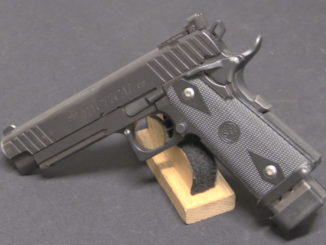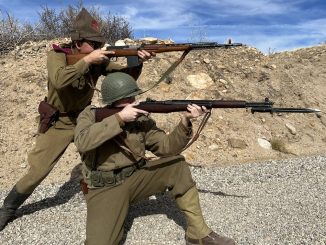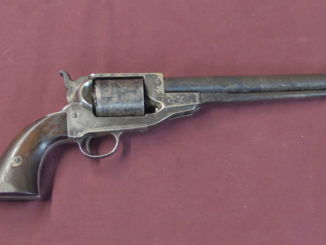Yesterday we took a look at the internals of Ruger’s select-fire AC-556, and today we have it out at the range. The main question for me was, how does it compare to the M16/AR-15? And the answer is, not all that well. The AR is definitely a softer shooting platform in full auto. The AC-556, despite being basically the same weight and using the same cartridge, jumps around a lot more. The reason is clear in the slow-motion footage; the bolt is slamming into the back of the receiver on each shot.
Related Articles

Semiauto pistol
Delta Force STI 2011: Competition Meets Operations
In the early 2000s (specifically 2006/2007, I believe) US Delta Force decided to replace its .45 ACP 1911 pistols with something having a larger magazine capacity. After testing a number of different platform initially, they […]

Competition
2-Gun on the Elbe: SVT40 vs M1 Garand
Today I’m taking an SVT-40 to the monthly 2-Gun Action Challenge Match, and I’m joined by my friend Tom shooting an M1 Garand. We’re both using moderately accurate gear, and so naturally I have a […]

Revolver
Shawk & McLanahan – A Would-Be St Louis Revolver Company
Revolver: https://jamesdjulia.com/item/52428-2-397/ Holster: https://jamesdjulia.com/item/52458-1-397/ The Shawk & McLanahan revolvers are a lesser-known example of a very low production Civil War era revolver not made in the Confederacy. Abel Shawk was manufacturing entrepreneur in St Louis […]

Forgotten Weapons, “We do fun things so you don’t have to”.
Does this also show the superiority of the the AR straight line stock
Not just. It’s easy to see now why this had an uphill battle against Stoner designs. We also have: bolt slam, cold accuracy, hot accuracy, mag change speed, 2 separate problems with the mode selector (which was also separate from the safety), optics accommodation, perhaps more.
“I hit something!”
Yes, he did hit something. To be fair, bowling pins are smaller targets than people. And unlike movie shootouts, where people start ducking the moment they hear gunfire, ducking AFTER a magazine dump is initiated within a 20 yard distance generally won’t save you from getting reduced to hamburger! Yes, I know I’ve messed up somewhere.
There is no doubt that Stoner was a genius.
Never before has there been a selective fire weapon as accurate as a as controllable or as accurate as the AR.I find his designs to be outstanding.with a floating barrel sub moa is the norm rather than the exception.
Basic physics at work against the AC 556 & Mini-14 contollabilty. I havent weighed the parts, but by handling would guess double (and spproaching triple) the weight of rearward moving parts in the Mini versus the AR.
‘Basic physics at work against the AC 556 & Mini-14 contollabilty. I havent weighed the parts, but by handling would guess double (and spproaching triple) the weight of rearward moving parts in the Mini versus the AR.”
And also at what time-frame…
Gas pressure in a Stoner AR-15 bolt has to force the bolt and bolt carrier apart, so for a good portion of that time-frame, only part of the BCG–the bolt carrier–is actually moving and part of that energy from the gas is actually pushing forward as well…
Its not only physics but dimensions, with such woodstock rifleish short receiver you cannot have slower rate of fire, and high rof lends to poor accuracy – nothing can be done here except installing some rof limiter, like in skorpion.
“(…)high rof lends to poor accuracy(…)”
Wait, according to https://modernfirearms.net/en/assault-rifles/u-s-a-assault-rifles/m16-a1-a2-a3-a4-eng/ M16A2 fire 750…950 rpm, whilst according to https://modernfirearms.net/en/assault-rifles/u-s-a-assault-rifles/ruger-ac-556-mini-14gb-eng/ 750 rounds per minute (for AC-556 only)
So Ruger weapon is not firing faster than triple-bullet M16.
I am wondering if AC-556 muzzle device is muzzle brake (i.e. pushing weapon backward) xor compensator (i.e. pushing muzzle downwards)? If first, would not replacing it with compensator helps against muzzle climb?
The Ruger Mini 13 BCG weighs about 380 grams.
Bcg? bolt carrier group?
The gas port on the mini is grossly oversized. I suppose to ensure reliability, but that comes at the cost of the bolt and associated hardware slamming back with some force. In shooting ARs and Minis, I have never had a jam with Minis (while using Ruger magazines) but have with ARs.
One can buy bushings to sleeve the gas port on the mini to drop the gas pressure to something reasonable while still being perfectly reliable.
Used to, back when all AR’s came from Colt, a Mini was significantly less expensive. And, before a decades of refinement on the AR, Mini’s had bullet proof reliability while the AR definitely did not. Mini’s also have an advantage in that a true side folding stock can be used to make into a handier package to lug around. All being said, yeah, I would probably go with an AR for serious use, but the Mini had, and has, some rationale behind it.
That ability to take a true side folding stock is intimately tied in with the poorer controllability.
The AR has its buffer, which converts some of the remaining energy of the reciprocating parts into heat, and dissipates it.
But, that buffer takes up space and precludes a side folding stock. The thin aluminium receiver also precludes using an AR stock for beating brains out with- at least If you still want a working rifle after doing that with it.
The AC 556 and Mini 14 also have drop between the bore line and the centre of the butt plate of the stock.
That allows for sights and optics to be mounted comfortably close to the bore axis.
What that comfortable drop in the stock also causes is the muzzle to lift as each bullet starts to move down the barrel.
That effect isn’t entirely bad, it results in positive compensation- where slower bullets are given a slightly higher trajectory than faster ones, and at some point down range- they all shoot to the same level.
But it still doesn’t make for contollability in bursts and full auto.
I guess that it’s swings and roundabouts.
What does a potential buyer want their gun to do?
“The thin aluminium receiver also precludes using an AR stock for beating brains out with- at least If you still want a working rifle after doing that with it.”
Vism & Karl Nill-Griffe got cha, fam.
The AR lower has also been made of mild steel – heavy as hell, but lends itself to welded steel buffer tubes. Known in the US as the Flat Spot lower.
“…The thin aluminium receiver also precludes using an AR stock for beating brains out…”(С)
“You should not read Soviet newspapers before dinner.” (C) 😉
When the M16 was accepted for supply, the possibility of hand-to-hand combat was considered with due attention.
The M16 case is significantly more durable than the AKM.
At least, the M16 does not become unusable after a couple of hundred shots from the grenade launcher.
What happens to the AKM / AK-74 after about 400 rounds.
I wish Ruger would make a Mini-14 SBR.
That clear magazine looks curiously like the 3-gun pre-ban RamLine, that was supposed to feed the AR-15, the Mini-14, & the AR-180. The RamLines do work in Minis & AR-15s; the one AR-180 I’ve tried it in had a magwell that was a bit too tight for the mag.
RamLines interestingly take MagPul 30 round springs as exact replacements.
Don’t forget that while Stoner designed the AR-10 is was Jim Sullivan who (more than anyone) redesigned the AR-10 into the AR-15. Guess who Bill Ruger hired to redesign the M-14 into the Mini-14? Jim Sullivan.
Circa 1973 when the mini was first sold what was the big complaint about the AR? It was that it jammed a lot. I think the idea may have been that there was not much wrong with the M-14 other than it being long and heavy. There must have been pressure to make the mini as reliable as possible.
Especially with a factory gas port, the mini does slam that bolt back. Anything in the chamber is ripped out (and ejected way out into the next county) and plenty of force left over to drive a new round home. Just like an M1A. The mini sort of reminds me of shooting a Browning long recoil action shotgun–seems to have a recoil impulse, then a final kick at the end for good measure. Have done some shooting with different minis, and with factory mags they just do not jam.
Who was it that later set about to create the constant recoil concept for making full auto more controllable? Jim Sullivan. Would be interesting if his work on the mini gave him some ideas on what tended to make things not controllable on full auto.
Stoner and Sullivan’s contributions to M16 should not be lumped together.
With all due respect to Sullivan, he is “only” a very competent and talented gunsmith.
But the leading genius tandem was still Stoner.
Who was able to predict the future direction of the development of the weapons system as a whole. And to understand what exactly is needed for the market and will be in demand.
In the mid-90’s I carried one of the short-barreled versions as part of a multi-agency team under Operation Cash Crop. Never fired it outside of training. It was a lot of fun, but it was so worn out from 20-some-odd years of being a bit of a range toy that accuracy was minute-of-small-room. Was also EXTREMELY persnickerty about magazines.
The ‘image’ of the M16 for good or ill ‘is’ what it is and I can totally see why avoiding it a substantial plus. But the firing downsides – as demonstrated, also substantial. Is there anyone out there that can give a real experience and opinion of these operationally?
I believe this is the gun they used in the old A Team tv show. No wonder they could never hit anything.
IIRC, they used the semi-auto stainless Mini14 with Choate replicas of the factory folder, Choate flash hider and aftermarket stainless 30 round mags. They never hit anything, whether with the Minis, pistols, SP1 AR15s, and the occasional M60.
The Mini/AC556 was never a viable military choice, though an adequate , and, as others have said cheap, LE/civ one.
I can’t believe the selector only moves with the hammer forward. I can’t see any reason why that should be the case mechanically (see previous video) and it would be a massive design flaw. I suspect that Ian’s test example was just a bit “sticky”.
Theres a early A-team episode where BA gets in a fire fight armed with a M16. The M16 jams and he gets thrown a AC556 which of course runs flawlessly and saves the day. I suspect this was a clever marketing ploy by Ruger who maybe sold the guns to the A-team production staff at a discount on the condition they jab at the M16 which had a reputation for jamming in the recently ended Vietnam war.
Possibly. Or maybe the Mini was cheaper and easier to convert to fire blanks, especially given its large rearward gas pressures, and advocated by the prop/blank gun supplier (Stembridge?) to the show.
The bad guys, IIRC, often had KG99s.
IIRC again, Miami Vice saw a mix of Beretta M12s, MP5s, KG99s, Uzi, and the odd “MAC10”. And the crew in “Air Wolf” had Uzi pistols.
There is an article to be written or video to be made on why particular guns end up in particular TV shows or movies.